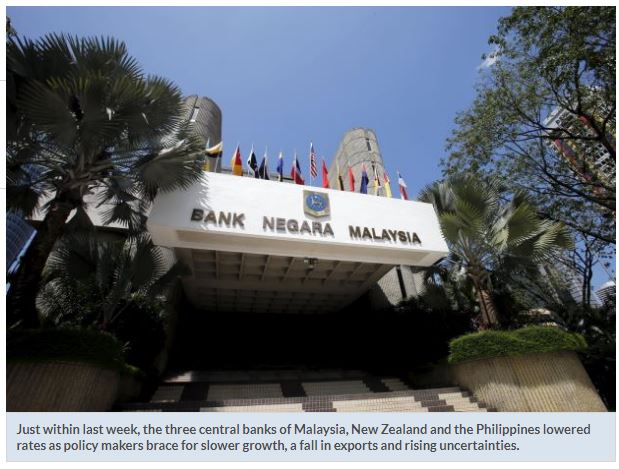Malaysia: Rate cuts are not enough to boost economic growth
With slowing world growth and an unstable trade and political environment, interest rate cuts are not enough to bolster economic growth.
In fact, over-reliance on rate cuts can be dangerous; the trend towards lower peak and trough rates in every rate cycle may lead to, among others, asset bubbles, debt pile-up and pension crises.
The efficacy of lower rates as part of monetary policy measures may be approaching an end, as several major economic zones such as in Europe and Japan, pursuing negative rates, saw their economies slow dramatically to near recession levels.
In the case of negative rates, the bank pays the borrower on the loan taken as in difficult economic conditions, consumers and businesses tend to hold on to their cash.
Germany’s economy narrowly avoided falling into a recession in the final three months of last year, as it registered zero growth in that quarter.
In Japan, the coincident index of business conditions posted its biggest decline in a year, of 2.7 points in January, prompting a comment from the government that the economy was ‘at a turning point towards a downgrade.’
Just within last week, the three central banks of Malaysia, New Zealand and the Philippines lowered rates as policy makers brace for slower growth, a fall in exports and rising uncertainties.
With the increase in US tariffs on Chinese imports, the Federal Reserve, which is now in pause mode, may also be possibly cutting rates if trade tensions prolong and affect consumer spending, a bulwark of the US economy.
As rates go lower, more and more debt will be channeled to fund each recovery phase.
At some point, the marginal efficiency of using more debts to boost economies, will drop so much that they will be unable to draw juice out of lowering rates.
With central banks appearing to have increasingly less room to manoeuvre, and policy options running out, it is feared that a catharsis may set in.
“Increasingly, they may choose to do nothing until a drastic economic slowdown sets in. Then, they will likely panic,’’ said Pong Teng Siew, head of research, Inter-Pacific Securities.
We may watch out for any sudden in-between Fed meeting for a rate cut; that could be a sign of panic setting in.
Bolstering domestic demand, which is the sum of consumption, public spending and investment, is a major although temporary step that will help offset the effects of slowing global trade and weaker manufacturing.
Increasing public spending on revived infrastructure projects and the level of minimum wages in Malaysia will, among other factors, help to stimulate domestic demand.
In the Philippines, stronger domestic demand against lower price pressures and higher public spending on infrastructure, is expected to help offset weak export demand.
In Indonesia, private investment is expected to pick up as some key public infrastructure projects are completed; private consumption remains robust with higher employment in the formal sector and social assistance programmes, said the Asian Development Bank.
China, which is pushing domestic consumption in a big way, has introduced a domestic consumption policy package that targets sectors that have been weakening, like automobiles.
Continued structural reforms is vital to boost productivity and competitiveness, create more jobs in the private sector and strengthen human capital.
“Intensification of risks highlights the need for continued investments in social assistance and insurance programmes to protect the most vulnerable,’’ said Dr Anthony Dass, head of AmBank Research.
As the risk of capital outflows heightens, adequate liquidity must be maintained to support monetary and financial systems.
Apart from healthy reserves, sustainable and resilient growth must be maintained through the optimisation of policy mix, and co-ordination between the government and relevant authorities, said Dr Dass.
The decline in productivity has become a major issue; to improve productivity, more incentives should be granted for, among other things, innovation and technology development, research and development, enhancement of skills and broadening of supply chains, said Danny Wong, CEO, Areca Capital.
In the long run, economies should draw up strategies for survival to make up for the expected, long term slowdown in manufacturing as globalization hits the reverse gear.
Globalisation entails greater international trade as economies become more interlinked and long term supply chains fostered.
With the disruption in trade and supply chains through escalation of tariffs and trade barriers, growth, long term business planning and hence, investments, are affected resulting in the weakening of the global manufacturing sector.
Already, global trade volumes have dropped at the fastest pace in a decade, falling 1.9% in the three months through February against the previous three months, reflecting how the slowdown, trade tensions and protectionist moves are starting to bite.
Columnist Yap Leng Kuen notes an unhealthy long-term weakening trend for manufacturing.
Source: https://www.thestar.com.my/business/business-news/2019/05/13/rate-cuts-are-not-enough-to-boost-economic-growth/#t3DODtH2bDygEwlG.99


 English
English




